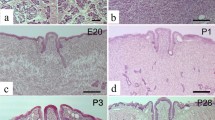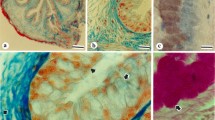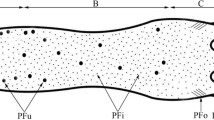Abstract
The eccrine nasolabial glands were found in the hypodermis of the nasal plane in the North American raccoon (Procyon lotor). In addition to light and electron microscopic observations, the distribution and selectivity of complex glycoconjugates in the eccrine tubular glands of the raccoon snout skin were studied using various histochemical methods, particularly lectin staining. The secretory epithelium and the luminal secretions exhibited high amounts of glycoconjugates with various saccharide residues (α-D-mannose, α-L-fucose, β-D-galactose, β-N-acetyl-D-glucosamine, sialic acid). The excretory duct cells also showed positive reactions with most of the histochemical methods applied. The results are discussed with regard to possible functions of the glandular secretions. The complex glycoconjugates that are produced by the eccrine nasolabial glands may be related to moistening of the skin surface as well as protecting the epidermis against physical damage or microbial contamination. This is the first report on the glands in the snout skin of carnivores.





Similar content being viewed by others
References
Ellis RA (1968) Eccrine sweat glands: electron microscopy, cytochemistry and anatomy. In: Jadassohn J (ed) Handbuch der Haut- und Geschlechtskrankheiten, Ergänzungswerk I/1. Springer, Berlin Heidelberg New York, pp 224–266
Calhoun ML, Stinson AW (1981) Integument. In: Dellman HD, Brown EM (eds) Textbook of veterinary histology, 2nd edn. Lea and Febiger, Philadelphia, pp 378–411
Hashimoto K, Hori K, Aso M (1986) Sweat glands. In: Bereiter-Hahn J, Matoltsy AG, Richards KS (eds) Biology of the integument, vol 2. Springer, Berlin Heidelberg New York, pp 339–373
Meyer W, Bartels T (1989) Histochemical study on the eccrine glands in the foot pad of the cat. Basic Appl Histochem 33:219–238
Halata Z (1993) Die Sinnesorgane der Haut und der Tiefensensibilität. In: Niethammer J, Schliemann H, Starck D (eds) Handbuch der Zoologie, vol VIII (Mammalia). De Gruyter, Berlin
Schwarz R, Meyer W (1994) Haut und Hautorgane. In: Frewein J, Vollmerhaus B (eds) Die Anatomie von Hund und Katze. P Parey, Hamburg, pp 316–340
Tsukise A, Meyer W, Schwarz R (1983) Histochemistry of complex carbohydrates in the skin of the pig snout, with special reference to eccrine glands. Acta Anat 115:141–150
Tsukise A, Fujimori O, Yamada K (1988) Histochemistry of glycoconjugates in the goat nasolabial skin with special reference to eccrine glands. Acta Anat 132:150–158
Tsukise A, Meyer W, Fujimori O, Yamada K (1988) The cytochemistry of glycoconjugates in the planum nasolabial glands of the goat as studied by electron microscopic methods. Histochem J 20:617–623
Meyer W, Tsukise A (1989) Histochemistry of glycoconjugates in the skin of the bovine muzzle, with special reference to glandular structures. Acta Anat 136:226–234
Yasui T, Tsukise A, Nara T, Habata I, Meyer W (2003) Histochemistry of glycoconjugates in the nasolabial skin of the Japanese serow (Capricornis crispus, Artiodactyla, Mammalia) with special reference to glandular structures. Eur J Morphol 41:43–51
Meyer W, Tsukise A (1995) Lectin histochemistry of snout skin and foot pads in the wolf and the domesticated dog (Mammalia: Canidae). Ann Anat 177:39–49
Bacha WJ Jr, Bacha LM (2000) Color atlas of veterinary histology, 2nd edn. Lippincott Williams and Wilkins, Baltimore
Luft JH (1961) Improvements in epoxy resin embedding methods. J Biophys Biochem Cytol 9:409–414
Watson ML (1958) Staining of tissue sections for electron microscopy with heavy metals. J Biophys Biochem Cytol 4:475–478
Reynolds ES (1963) The use of lead citrate at high pH as an electron opaque stain in electron microscopy. J Cell Biol 17:208–212
Rittman BR, Mackenzie IC (1983) Effects of histological processing on lectin binding patterns in oral mucosa and skin. Histochem J 15:467–474
Allison RT (1987) The effects of various fixatives on subsequent lectin binding to tissue sections. Histochem J 19:65–74
Alroy J, Ucci AA, Pereira MEA (1988) Lectin histochemistry: an update. In: DeLellis RA (ed) Advances in immunohistochemistry (neoplasm diagnosis). Raven, New York, pp 93–131
Spicer SS, Horn RG, Leppi TJ (1967) Histochemistry of connective tissue mucopolysaccharides. In Wagner BM, Smith DE (eds) The connective tissue. Williams and Wilkins, Baltimore, pp 251–303
Lev R, Spicer SS (1964) Specific staining of sulphate groups with Alcian blue at low pH. J Histochem Cytochem 12:309
Pearse AGE (1968) Histochemistry, theoretical and applied, 3rd edn, vol 1. Churchill Livingstone, London
Nakamura M, Kitamura H, Yamada K (1985) A sensitive method for histochemical demonstration of vicinal diols of carbohydrates. Histochem J 17:477–485
Kitamura H, Nakamura M, Yamada K (1988) The utility of two physical developers for certain histochemical methods for glycoconjugates in light and electron microscopy. In: Glycoconjugates in medicine (Proceedings of an International Symposium, Kagoshima, Japan). Professional Postgraduate Services, Tokyo, pp 24–28
Yamada K (1993) Histochemistry of carbohydrates as performed by physical development procedures. Histochem J 25:95–106
Hirabayashi Y (1992) Light-microscopic detection of acidic glycoconjugates with sensitized diamine procedures. Histochem J 24:409–418
Ueda T, Fujimori O, Yamada K (1995) A new histochemical method for detection of sialic acids using a physical development procedure. J Histochem Cytochem 43:1045–1051
Debray H, Decout D, Strecker G, Spik G, Montreuil J (1981) Specificity of twelve lectins towards oligosaccharides and glycopeptides related to N-glycosylproteins. Eur J Biochem 117:41–55
Spicer SS, Schulte BA (1992) Diversity of cell glycoconjugates shown histochemically: a perspective. J Histochem Cytochem 40:1–38
Danguy A (1995) Perspectives in modern glycohistochemistry. Eur J Histochem 39:5–14
Spicer SS (1960) A correlative study of the histochemical properties of rodent acid mucopolysaccharides. J Histochem Cytochem 8:18–35
Casselman WGB (1959) Histochemical technique. Methuen, London
Stumpf P, Welsch U (2002) Cutaneous eccrine glands of the foot pads of the Rock hyrax (Procavia capensis, Hyracoidea, Mammalia). Cells Tissues Organs 171:215–226
Montagna W, Parakkal PR (1974) The structure and function of skin, 3rd edn. Academic Press, New York
Stenn KS (1988) The skin. In: Weiss L (ed) Cell and tissue biology. Urban and Schwarzenberg, Baltimore, pp 539–572
Gebhart W (1989) What is new on sweat glands. Dermatologica 178:121–122
Schaumburg-Lever G, Metzler G, Tronnier M (1991) Ultrastructural localization of lectin-binding sites in normal human eccrine and apocrine glands. J Dermatol Sci 2:55–61
Sbarbati A, Osculati A, Morroni M, Carboni V, Cinti S (1994) Electron spectroscopic imaging of secretory granules in human eccrine sweat glands. Eur J Histochem 38:327–330
Sames K, Moll I, van Damme EJM, Peumans WJ, Schumacher U (1999) Lectin binding pattern and proteoglycan distribution in human eccrine sweat glands. Histochem J 31:739–746
Yasui T, Tsukise A, Meyer W (2004) Histochemical analysis of glycoconjugates in the eccrine glands of the raccoon digital pads. Eur J Histochem 48:393–402
Yasui T, Tsukise A, Meyer W (2005) Ultracytochemical demonstration of glycoproteins in the eccrine glands of the digital pads of the North American raccoon (Procyon lotor). Anat Histol Embryol 34:56–60
Sato K, Kang WH, Saga K, Sato KT (1989) Biology of sweat glands and their disorders. I. Normal sweat gland function. J Am Acad Dermatol 20:537–563
Pearse AGE (1985) Histochemistry, theoretical and applied, 4th edn, vol 2. Churchill Livingstone, Edinburgh
Mandal C, Mandal C (1990) Sialic acid binding lectins. Experientia 46:433–441
Ueda T, Fujimori O, Tsukise A, Yamada K (1998) Histochemical analysis of sialic acids in the epididymis of the rat. Histochem Cell Biol 109:399–407
Reid PE, Park CM (1990) Carbohydrate histochemistry of epithelial glycoproteins. Prog Histochem Cytochem 21:1–170
Reuter G, Schauer R (1987) Isolation and analysis of gangliosides with O-acetylated sialic acids. In: Rahmann H (ed) Gangliosides and modulation of neuronal functions. NATO ASI series, H7. Springer, Berlin Heidelberg New York, pp 155–165
Schauer R, Fischer C, Lee H, Ruch B, Kelm S (1988) Sialic acids as regulators of molecular interactions. In: Gabius HJ, Nagel GA (eds) Lectins and glycoconjugates in oncology. Springer, Berlin Heidelberg New York, pp 5–23
Majima Y, Harada T, Shimizu T, Takeuchi K, Sakakura Y, Yasuoka S, Yoshinaga S (1999) Effect of biochemical components on rheologic properties of nasal mucus in chronic sinusitis. Am J Respir Crit Care Med 160:421–426
Meyer W, Bollhorn M, Stede M (2000) Aspects of general antimicrobial properties of skin secretions in the common seal Phoca vitulina. Dis Aquat Organ 41:77–79
Meyer W, Neurand K, Tanyolac A (2001) General anti-microbial properties of the integument in fleece producing sheep and goats. Small Rumin Res 41:181–190
Meyer W, Neurand K (1991) Comparison of skin pH in domesticated and laboratory mammals. Arch Dermatol Res 283:16–18
Schulte BA, Spicer SS, Miller RL (1985) Lectin histochemistry of secretory and cell-surface glycoconjugates in the ovine submandibular gland. Cell Tissue Res 240:57–66
Macfarlane WV (1968) Comparative functions of ruminants in hot environments. In: Hafez P (ed) Adaptation of domestic animals. Lea and Febiger, Philadelphia, pp 264–276
Majeed MA, Zaidi IH, Ilahi A (1970) The nature of nasolabial gland secretion (NLGS) in large domestic ruminants. Res Vet Sci 11:407–410
Toutain PL, Bueno I, Magnol JP (1973) Aspects fonctionnels du muffle chez les bovines. Cah Med Vet 42:41–48
Laden SA, Schulte BA, Spicer SS (1984) Histochemical evaluation of secretory glycoproteins in human salivary glands with lectin-horseradish peroxidase conjugates. J Histochem Cytochem 32:965–972
Author information
Authors and Affiliations
Corresponding author
Rights and permissions
About this article
Cite this article
Yasui, T., Tsukise, A. & Meyer, W. Morphology and glycoconjugate histochemistry of the eccrine glands in the snout skin of the North American raccoon (Procyon lotor). Arch Dermatol Res 296, 482–488 (2005). https://doi.org/10.1007/s00403-004-0539-3
Received:
Revised:
Accepted:
Published:
Issue Date:
DOI: https://doi.org/10.1007/s00403-004-0539-3




